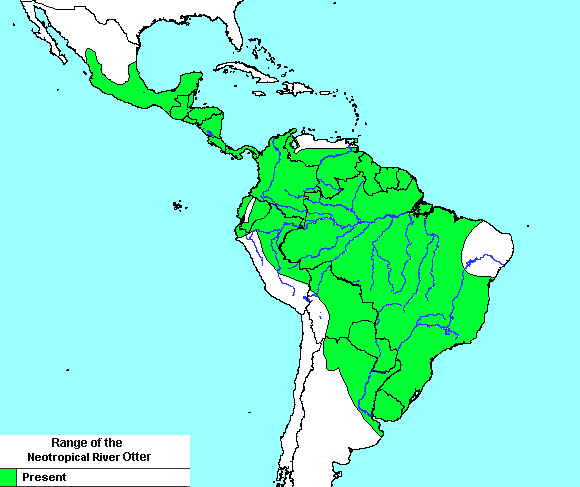Geographical Range of the Neotropical Otter
This is from Waldemarin (2004).

Although the species' range appears large, and is more or less the same as its historical range, there is a lack of information about population, numbers of mature animals, and actual distribution. It is assumed that the population is large if sparse, but there is little hard evidence to support this.
The species ranges from northern Argentina up through south and central America to Mexico. There is then an otter-free arid zone between it and the North American River Otter.
The CITES website gives a number of
countries where the existence of the Neotropical Otter is established:
Argentina, Belize.; Bolivia.; Brazil.; Colombia.; Costa Rica,
Guyana, Paraguay, Peru, Suriname, Uruguay, Venezuela and Mexico.
Another list is given of countries where its presence is in doubt.
For one of these, Ecuador, since Castro-Revelo
& Zapata-Rios (2001) give an altitude record for the species, it
can be assumed to be present. For the rest, local tourism websites
indicate that there are at least some present, regarding them as
attractions for visitors. For El Salvador, Carlos
Restrepo observed them in El Jocotal Lagoon in 2001. For
Guatemala, several tourism websites mention them, such as Tortugal
Marina on the Rios Dulce, and Parque
Nacional Laguna Lachu. In Honduras, The
Lodge at Pico Bonito Honduras speaks of River Otters, and in
Nicaragua, otters are to be found on the San Juan River in the south-east
according to Nicaraguan
Adventures. In Panama, Thomson
Family Adventures locates them on the River Esti. Emperor Valley
Zoo on Trinidad has a picture of an otter cub sourced locally, so they
must be present on the island, but Environment
Tobago says that although otters were originally found on Tobago, they
were rapidly wiped out by the early settlers.
This leaves French Guiana as an area devoid of Neotropical Otters, but since the Giant Otter is present there, it may be that the smaller, quieter, shyer and less glamorous Neotropical Otter is also present but unrecorded.
| Neotropical River Otter |

